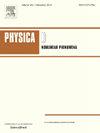richmyer - meshkov不稳定性数值模拟的前跟踪/鬼流体方法
IF 2.7
3区 数学
Q1 MATHEMATICS, APPLIED
引用次数: 0
摘要
本文提出了一种精度越来越高、鲁棒性越来越强的前跟踪(FT)方法,并结合幽灵流体方法(GFM)对激波诱导湍流混合进行了数值模拟。采用高阶加权本质非振荡(WENO)格式的FT-GFM方法研究了可压缩流动中复杂运动流体界面的演化。我们在几个测试问题上证明了具有单调保持界的高阶WENO方案在流体界面的后期动力学方面的改进和效果。通过一维标量平流、Sod激波管、激波-熵相互作用问题以及空气与SF6之间二维激波管richhtmyer - meshkov不稳定性(RMI)的模拟,展示了新方法所取得的改进。在激波驱动界面问题的数值解中,研究了具有和不具有单调保界的五阶和九阶WENO格式。本文章由计算机程序翻译,如有差异,请以英文原文为准。
A front-tracking/ghost-fluid method for the numerical simulations of Richtmyer–Meshkov Instability
We present an increasingly accurate and robust front-tracking (FT) method coupled with the ghost-fluid method (GFM) for the numerical simulations of shock-induced turbulent mixing. The FT-GFM method with the higher-order weighted essentially non-oscillatory (WENO) schemes is used to study the evolution of the complex and moving fluid interfaces in compressible flows. We demonstrate the improvements in the late-time dynamics of the fluid interfaces and the effect of the high-order WENO schemes with monotonicity preserving bounds on several test problems. One-dimensional scalar advection, Sod’s shock tube, shock-entropy wave interaction problems, and two-dimensional shock tube Richtmyer–Meshkov instability (RMI) between air and SF simulations are performed in order to show the improvements achieved using the new method. The fifth- and ninth-order WENO schemes with and without monotonicity preserving bounds are explored in the numerical solution of the shock-driven interface problem.
求助全文
通过发布文献求助,成功后即可免费获取论文全文。
去求助
来源期刊

Physica D: Nonlinear Phenomena
物理-物理:数学物理
CiteScore
7.30
自引率
7.50%
发文量
213
审稿时长
65 days
期刊介绍:
Physica D (Nonlinear Phenomena) publishes research and review articles reporting on experimental and theoretical works, techniques and ideas that advance the understanding of nonlinear phenomena. Topics encompass wave motion in physical, chemical and biological systems; physical or biological phenomena governed by nonlinear field equations, including hydrodynamics and turbulence; pattern formation and cooperative phenomena; instability, bifurcations, chaos, and space-time disorder; integrable/Hamiltonian systems; asymptotic analysis and, more generally, mathematical methods for nonlinear systems.
 求助内容:
求助内容: 应助结果提醒方式:
应助结果提醒方式:


